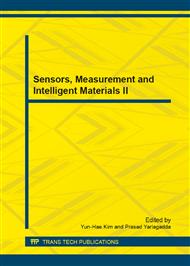[1]
Mitola III J, Maguire JR G Q. Cognitive radio: making software radios more personal [J]. IEEE Personal Communications, 1999, 6(4): 13-18.
DOI: 10.1109/98.788210
Google Scholar
[2]
Haykin S. Cognitive radio: brain-empowered wireless communications [J]. IEEE journal on Selected Areas in Communications. 2005, 23(2): 201-220.
DOI: 10.1109/jsac.2004.839380
Google Scholar
[3]
Wei Qi. Study on Anti-jamming Technology Based on Cognitive Radio[J]. Radio Communications Technology, 2011(4): 56-58. (in Chinese).
Google Scholar
[4]
Li hui, Su Zeyou, Xie wei. The Design Speculation Of Connitive Radio Comprehensive Anti-Jamming Radio Station[C]. The 15th academy annual meeting on information theory, Chinese Institute of Electronics, 2008: 331-335 (in Chinese).
Google Scholar
[5]
German E H. Transform domain signal processing study final report[R]. Reisterstown, MD: Air Force Research Laboratory, US, (1988).
Google Scholar
[6]
Orr R S, Pike C, Lyall J J. Wavelet transform domain communication systems[C]/ Proceedings SPIE Conference. USA: SPIE Publisher, 1998, 2(1): 271- 282.
Google Scholar
[7]
Zhang Yan-xian, Yi Yu-yan, Han Peng: An MC-CDMA system with ability of warring and avoiding interference [J]. Communication and Network. 2009(7): 116-118. (in Chinese).
Google Scholar
[8]
Gu Qing-feng, Yang Shi-ping: A Multiband Frequency-hopping Communication System Based on Cognitive Radio[J] . Telecommunication Engineering. 2012, 52(7): 1079-1081 (in Chinese).
Google Scholar
[9]
Cheng Zhuo: Research on Interference Suppression Technologies in Cognitive-Based Differential Frequency Hopping Network[D]. PhD thesis. Huazhong University of Science and Technology, China, 2010. (in chinese).
Google Scholar
[10]
ZHANG Shi-bing, ZHANG Guo-an, JI Xiao-dong. Multiple Access and Anti-interference Strategy for Cognitive Ultra-wideband Radio[J]. Journal of Nantong Oniversity ( Natural Science Edition ), 2008, vol. 7(1): 17-20. (in Chinese).
Google Scholar
[11]
Yang Er-yong, Cheng Jian-zhong, Niu Ying-tao: Antijamming Communication Decision Engine Based on Genetic Algorithm(GA) [J]. Journal of Military Communications Technology. 2011, vol. 32(1). Page(s): 22-26 (in Chinese).
Google Scholar
[12]
Yongxin Wang, Supeng Leng: Joint Power and Rate Control in Cognitive Network with External Interference[C]/2011 3rd IEEE International Conference on Communication Software and Networks (ICCSN 2011). Page(s): 293 - 296.
DOI: 10.1109/iccsn.2011.6013596
Google Scholar
[13]
You Changjiang, Liu Jing, Zhang Xiaodong and etc: Reconfigurable anti-interference RF transceiver for cognitive radio application [J]. Journal of Southeast University (English Edition). 2011, 27(2): 123-127.
Google Scholar


